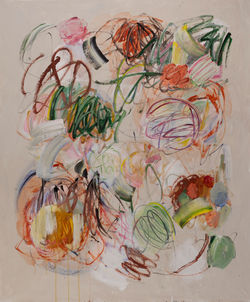JACQUES BAGE
JACQUES BAGE
SELECTED WORK
JACQUES BAGE
SELECTED WORK
JACQUES BAGE
JACQUES BAGE
SELECTED WORK
JACQUES BAGE
SELECTED WORK
SELECTED WORK
ANGELO VULLO
SELECTED WORK
SELECTED WORK
Cette peinture s’est développée un temps selon divers motifs décoratifs. Mais elle ne s’y limita nullement. Comme pour bon nombre d’artistes de la modernité (depuis Matisse jusqu’à Wim Delvoye, en passant par Christopher Wool) l’usage des arts décoratifs d’Orient ou d’Occident est ici le moyen d’accéder à une force de l’art que les images ne procurent pas, ou rarement.
Ensuite, Angelo intensifia son décorum pictural en termes de réseau. Ce dernier étant à vrai dire aujourd’hui, l’incarnation la plus vive des trames anciennes de la mosaïque et de la tapisserie. Grande maturité de cette peinture et correspondance même dans la recherche et la durée avec les technologies de notre temps. Les réseaux d’Angelo Vullo m’apparaissent comme les textiles minéraux d’un vaste entrelacs pixellisé. Quelque chose d’ancestral et de nouveau, comme si Seurat, Klee, Byzance, Mondrian, Bonnard et quelques autres pouvaient ici être relus.
Le décoratif, en effet, est une voie royale de l’abstraction. On y géométrise le sensible sans pour autant le soustraire au plaisir d’un chacun. Les Primitifs le savaient, y encourageant une écriture visuelle collective. En quelque sorte, Angelo Vullo expérimenta là sa peinture comme une sorte de milieu. Le spectateur ne la regardait pas à distance mais selon une sorte de corps-à-corps avec une couleur florale.
Pierre Sterckx, 2013


CLAUDIE LAKS
AVAILABLE WORK
Les coloris du charivari happent le regard, le ravissent. Cette extase visuelle me comble et me rend les paradis perdus. Tous les colibris de l’Eden. La touche est intuitive, mobile, et sagace. Les vrais artistes, à mes yeux, sont ceux qui obéissent à leurs pulsions, aux impératifs de leur inconscient sans perdre leur clairvoyance. Claudie Laks voit les toupies de couleurs organiser spontanément leur cosmos. Mais cette spontanéité est le fruit d’une concentration lucide. (...)
(...) Les jardins merveilleux de Claudie, aériens, vibratiles ne sont pas de ce monde. Il faut traverser le mur du déterminisme pour les retrouver dans l’impromptu, l’aléa fantastique, l’imprévisibilité dionysiaque…
Texte : Patrick Grainville, 2023, de l’Académie française.
Extrait du catalogue, Claudie Laks, CHARIVARI, juin 2023

 Orgiaque et MélancoliqueClaudie LAKS - 2022, Diptyque 203 x 326 cm - Acrylic on canvas |  VolageClaudie LAKS - 2022 - 140 x 203 cm - Acrylic on canvas |  Twin paintingClaudie LAKS - 2020 - 204 x 162 cm - Acrylic on canvas |  Sous les pavés la plageClaudie LAKS - 2022 - 213 x 179 cm - Acrylic on canvas |
|---|---|---|---|
 Sans blagueClaudie LAKS - 2022 - 202 x 168 cm - Acrylic on canvas |  Les EstivesClaudie LAKS - 2022 - 202 x 168 cm - Acrylic on canvas |  CrayonnéClaudie LAKS- 2022, 213 x 168 cm - Acrylic on canvas |  Les chosesClaudie LAKS - 2021 - 205 x 217 cm - Acrylic on canvas |
 Chat qui chavireClaudie LAKS 2023 204 x 162 cm - Acrylic on canvas |  Gymnopédie 1Claudie LAKS - 2022 - 203 x 164 cm - Acrylic on canvas |  ControversesClaudie LAKS - 2022 - 203 x 140 cm - Acrylic on canvas |  Halo limoneuxClaudie LAKS - 2022 - 203 x 141 cm - Acrylic on canvas |
 ChrysophyleClaudie LAKS - 2022 - 140 x 203 cm - Acrylic on canvas |  CalypsoClaudie LAKS - 2020 - Calypso - 202 x 137 cm - Acrylic on canvas |  Collage YellowClaudie LAKS 2018 - 77 x 57 cm - mixed media |  DécollementClaudie LAKS - 2020 - 76 x 57 cm - Collage - mixed media |
 OutremerClaudie LAKS - 2019 - 65 x 50 cm - Collage - mixed media |  Oh combienClaudie LAKS - 2021 - 76 x 57 cm - Collage - mixed media |  Alors !Claudie LAKS - 2021 - 76 x 57 cm - Collage - mixed media |  Collage, 2018, 65 x 50 cmClaudie LAKS - 2018 - 65 x 50 cm - Collage - mixed media |
 FollementClaudie LAKS - 2021 - 76 x 57 cm - Collage - mixed media |  Collage MulticolorClaudie LAKS - 2019 - 65 x 50 cm - Collage - mixed media |  Sans douteClaudie LAKS - 2021 - 76 x 57 cm - Collage - mixed media |